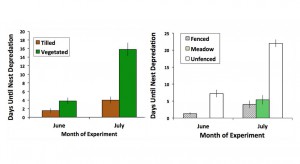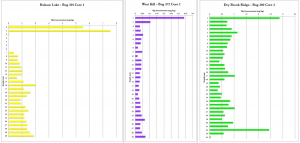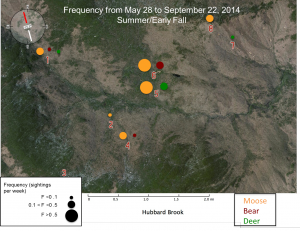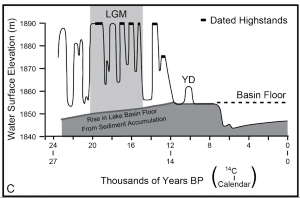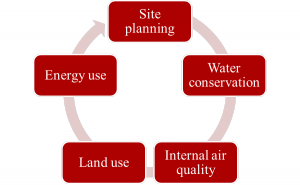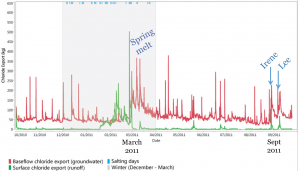Get involved
The ERI funds and conducts a wide range of short term and long term projects for faculty and students. You can get involved
- by taking on a project faculty want to see done, for example, from this list,
- by seeking URSI summer projects
- by finding independent research opportunities on campus or off campus, with support from ERI.
Below are examples of recent and ongoing projects supported by the ERI
Visualizing the Corn Belt in a changing climate
Mary Ann Cunningham (Geography)
A temperature increase of 2-4°C could impact growing conditions in future decades. Dramatic changes in agricultural production are likely to be disruptive. This project uses models of drought, food demand, and economic drivers to examine how climate change will affect U.S. corn production. Results indicate that the distribution of suitable climate conditions for corn decreased in area and moved north. Much of the current Corn Belt will be outside the tolerance range of this crop.
Read more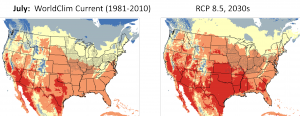
Blanding’s Turtles of Dutchess County
Marshall Pregnall (Biology)
The Blanding’s turtle is down to one population in the region. This population of turtles is being monitored and radiotagged, and their nesting behavior studied. Due to the vulnerability of the population, it is important to monitor Blanding’s turtle reproduction, particularly their nests which are frequently preyed upon. Results indicate that Blanding’s turtles prefer nesting in tilled sites, but such sites are also more vulnerable to predators.
Read more
Edith Roberts Ecological Laboratory
Meg Ronshiem (Biology and Environmetal Studies)
Meg Ronshiem has led an ongoing project to restore the Edith Roberts Ecological Laboratory, an outdoor lab designed and built by Professor Roberts and her students in the 1930s. This is one of the earliest ecological restoration projects in the United States, as it transformed an old field into a sequence of characteristic plant associations of Dutchess county. This project has employed summer students and taught many classes about local flora and fauna.
Mercury and Lead Deposition in Ombrotrophic Catskill Bogs
Alison Keimowitz (Chemistry)
Ombrotrophic bogs are sensitive ecosystems dependent on atmospheric deposition of precipitation for their survival. Given their isolation, these sites are vulnerable to airborne pollutants such as mercury and lead, and also act as good archives of atmospheric changes. Bogs accumulate material through time, with recent deposition in the upper layers. Bog cores can be used to examine changes in chemistry through time. Anthropogenic pollutants are more concentrated in upper levels of bog cores.
Read more
Animals and Nutrient Cycling
Lynn Christenson (Biology)
Animals can have both direct and indirect effects on nutrient cycling: selective browsing on preferred species of vegetation influences plant community composition, and urine and feces also act in nutrient cycling. A study in Hubbard Brook looked for sightings of large animals (deer, moose, bear) to see where these animals frequent and how that might affect forest ecosystems, trophic structures, and nutrient cycling.
Read more
Last Glacial Maximum Climate in the Estancia Basin
Kirsten Menking (Earth Science)
During the Last Glacial Maximum, Estancia Basin (New Mexico) was home to a large lake, which arose due to different precipitation and climate patterns from today. By looking at sediment records from the ancient Lake Estancia, it is possible to interpret changes in climate that occurred around 20,000 years ago. These sediments reveal that the lake experienced several abrupt oscillations between high and low levels.
Read more
Can Chinese government green China’s buildings?
Yu Zhou (Geography)
A green building is one designed to be environmentally sustainable in its construction and operation. China’s rapid development and urbanization make it a good candidate for a green building program. However, for a green building program to succeed, it is necessary to engage stakeholders and encourage public awareness and participation.
Read more
Annual Variations in Salt Export in the Casperkill
Cassandre Stirpe (ERI Collins Fellow)
Road-salt is applied each winter to ensure the safety of drivers and pedestrians, but the environmental consequence is that the road-salt accumulates in the watershed and pollutes local streams. This study examined salt concentrations and export in the Casperkill, and found that 89% of salt export occurs during baseflow, with only 11% occurring during winter salting seasons.
Read more
Salting Impact on Vassar Campus Soils
Cassandre Stirpe (ERI Collins Fellow)
Soil cores were collected and tested for evidence of chemical degradation due to road salt. Water filtered through soils was examined for high concentrations of sodium and chloride, the most common components of road salt (NaCl). A total of ten sites were selected for sampling, with five occurring next to pavement, and five further downslope near streams. Results indicate that all ten sites are negatively affected by salt, but the type of impact varies by location: sodium accumulates near roadways, while chloride accumulates near streams.
Read more
Assessing Winter Season Severity
Cassandre Stirpe (ERI Collins Fellow)
Using the Accumulated Winter Season Severity Index (AWSSI), scores were calculated to determine the severity of each winter season from 1966-67 to 2015-16, a total of 50 years. The winter severity score was derived from both temperature and snowfall conditions during each winter season. Total AWSSI scores showed variability from year to year, but long-term trends indicate a linear decline in 10-year AWSSI averages.
Read more.

